This comprehensive guide to Chicken Stir Fry with Oyster Sauce invites you to bring the vibrant, authentic flavors of your favorite Chinese takeout right into your home kitchen. Designed for ultimate customization and ease, this recipe will quickly become a weeknight favorite!
Mastering the perfect Chicken Stir Fry Sauce is the secret to replicating those irresistible Chinatown flavors. Forget expensive and often unhealthy restaurant meals; with this recipe, you can effortlessly create a genuinely delicious and healthy stir fry at home.
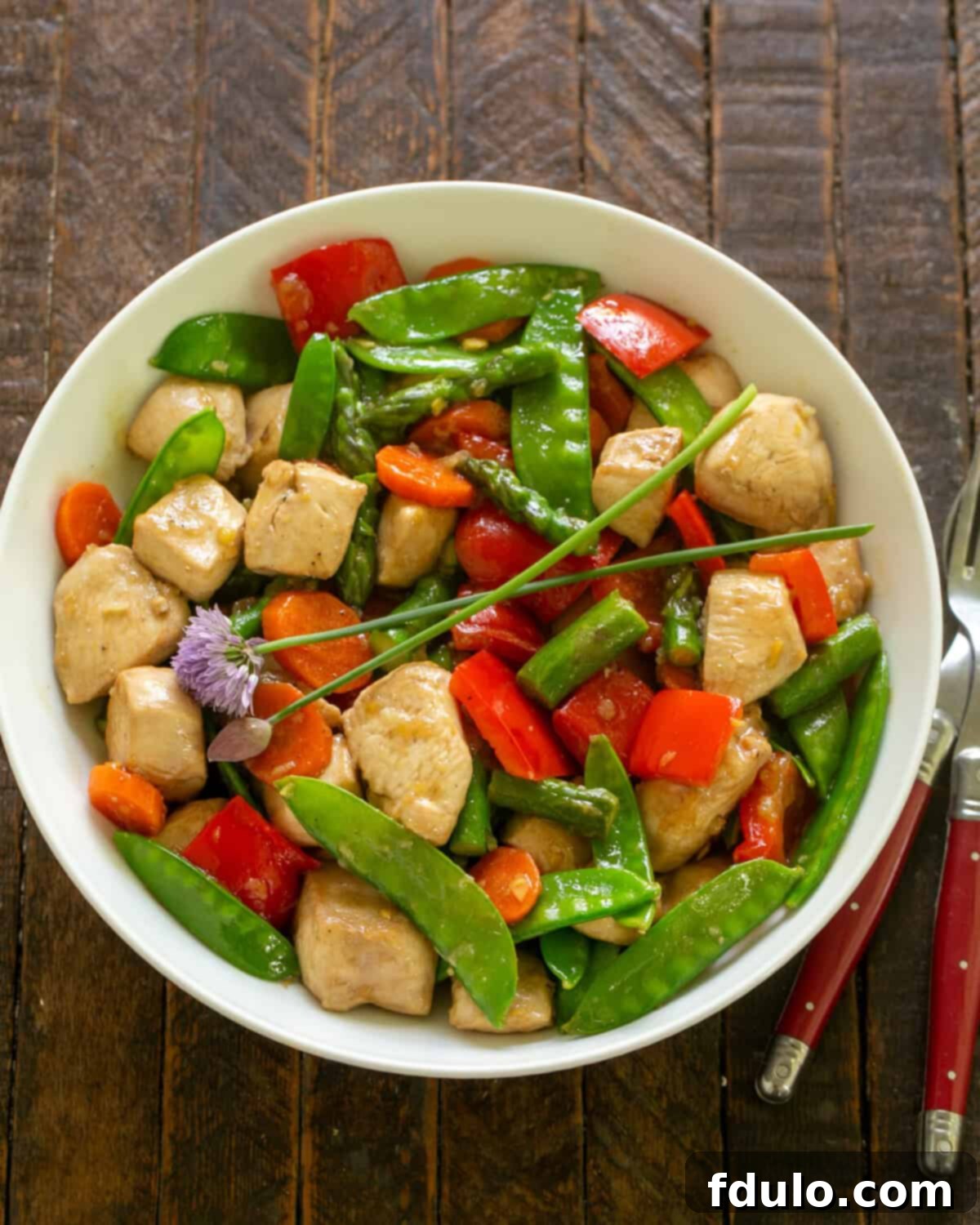
Why This Chicken Stir Fry Will Become Your New Go-To Recipe
My culinary journey with Asian cuisine began humbly with my mom’s Egg Foo Yung, a simple dish of fried eggs, a can of mixed vegetables (bean sprouts included!), and soy sauce. It wasn’t gourmet, but it ignited a lifelong love. Years later, a memorable dinner at The House of Lum in Aspen, Colorado, introduced me to a broader world of traditional Chinese dishes – from steaming won ton soup and crispy egg rolls to fortune cookies at the end. These early experiences shaped my appreciation for authentic flavors and inspired me to recreate them.
- When I first stumbled upon this particular Chicken Stir Fry with Oyster Sauce recipe from Pam Anderson’s The Perfect Recipe, I knew instantly that I had discovered a keeper – a dish I would return to again and again. Its simplicity and incredible depth of flavor were unparalleled.
- While the recipe might not be strictly “authentic” in the most traditional sense, it perfectly captured the essence of the Chinese restaurant food I grew to adore. It evoked memories of summer evenings in Aspen and our culinary explorations through Vancouver’s bustling Chinatown during our year abroad. The flavors were remarkably spot on, delivering that coveted takeout taste without leaving your home.
- Stir-fry recipes are truly a godsend for anyone seeking quick, delicious, and healthy dinners, especially on busy weeknights. They are incredibly versatile, allowing you to incorporate a wide array of ingredients based on what you have on hand or what’s in season, making meal planning a breeze.
- Beyond its speed and adaptability, homemade stir fry offers significant health advantages. You have complete control over the quality of ingredients, the amount of oil used, and the sodium content, ensuring a fresh and nutritious meal for your family.
- This recipe isn’t just a meal; it’s an experience. It’s the joy of creating something truly flavorful and satisfying that rivals, if not surpasses, your favorite restaurant versions, all while fostering a love for cooking diverse cuisines in your own kitchen.
Essential Ingredients for a Flavorful Chicken Stir Fry
Crafting an exceptional stir fry starts with understanding your ingredients. Here’s a breakdown of what you’ll need, along with tips for selection and preparation:
- Kitchen Staples: You’ll need high-quality Soy Sauce (preferably low-sodium), granulated Sugar, fresh Ground Black Pepper, a neutral Vegetable Oil with a high smoke point (like canola or peanut oil), and Cornstarch for thickening. These form the base of many Asian-inspired dishes.
- Boneless, Skinless Chicken Breasts: For best results, slice or cube the chicken into uniform, bite-sized pieces. This ensures even cooking and a tender texture. You can also opt for boneless, skinless chicken thighs for a slightly richer flavor and even more tender results. Ensure all pieces are roughly the same size as your vegetables.
- Dry Sherry: This Spanish fortified wine plays a crucial role in the marinade, not only adding a layer of complex flavor but also helping to tenderize the chicken. Keep a bottle in your refrigerator for various recipes. If you don’t have sherry, a dry white wine or even a small amount of rice vinegar can be a substitute, though the flavor profile will shift slightly.
- Assorted Vegetables: The beauty of stir fry lies in its versatility. Cut or slice all vegetables into bite-sized pieces, aiming for roughly the same size as your chicken. This promotes even cooking. I personally enjoy the crispness of snow peas, the slight bitterness of asparagus, the sweetness of red bell peppers, and the earthy crunch of carrots. Other excellent choices include broccoli florets, snap peas, bok choy, mushrooms, water chestnuts, baby corn, and onions. Prioritize fresh, seasonal produce for the best taste and texture.
- Oyster Sauce: This savory, slightly sweet, and umami-rich sauce is the heart of our stir-fry flavor. It’s readily available in the international aisle of most grocery stores. Don’t let the name deter you; it doesn’t taste overtly fishy but provides a wonderful depth. Look for good quality brands for the best flavor.
- Sesame Oil: A drizzle of toasted sesame oil at the end adds an unmistakable nutty, aromatic “Asian” flavor that elevates the entire dish. A little goes a long way, so use it sparingly.
- Fresh Garlic: For intense flavor, use fresh garlic. A garlic press is excellent for quickly “mincing” it, or you can finely chop it with a knife. The potent aroma and taste of fresh garlic are irreplaceable in a stir fry.
- Fresh Ginger: Similar to garlic, fresh ginger offers a pungent, slightly spicy warmth that is essential to the stir-fry’s profile. I prefer using a microplane or zester for finely “mincing” it, ensuring it disperses evenly throughout the dish without large chunks. Alternatively, peel the ginger and chop it very finely on a cutting board.
- Steamed Rice: To complete this magnificent meal, serve your stir fry over fluffy steamed rice. Always cook your rice in salted water or broth unless dietary restrictions prohibit it. A perfectly seasoned rice acts as a delicious canvas for the stir-fry flavors. My kids still recount the time my husband Bill made unseasoned rice years ago when I was out of town – a testament to how crucial proper seasoning is!

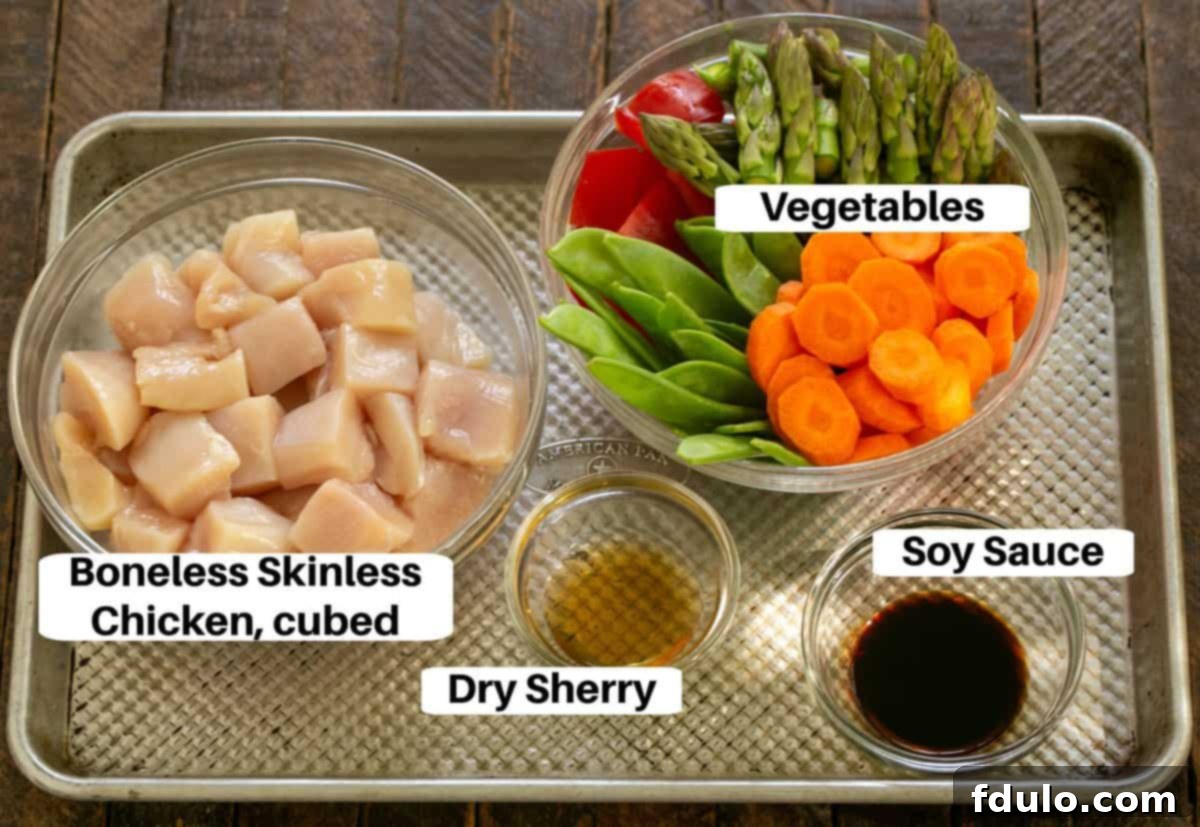
How to Make Your Best Chicken Stir Fry
Creating a successful stir fry is all about preparation and speed. Follow these steps for a delicious meal:
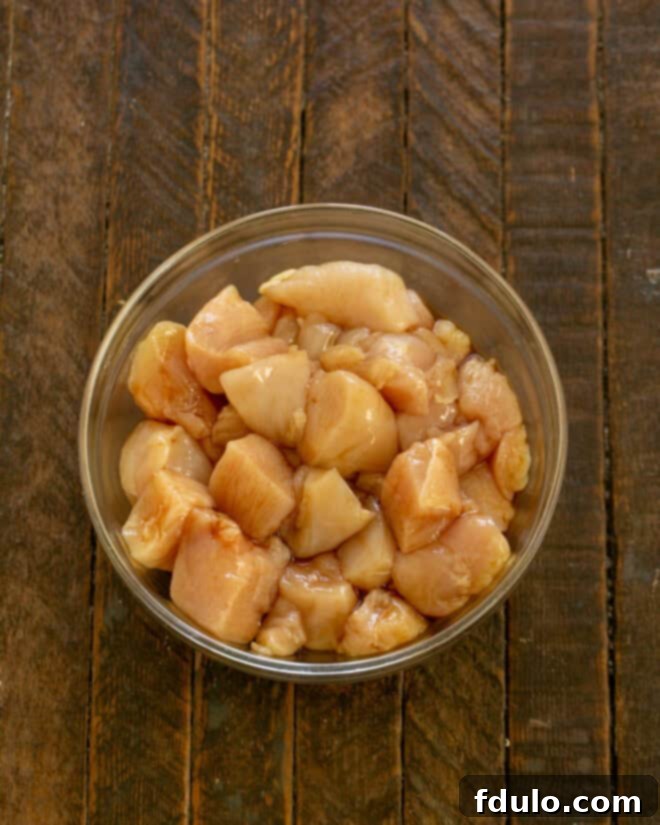

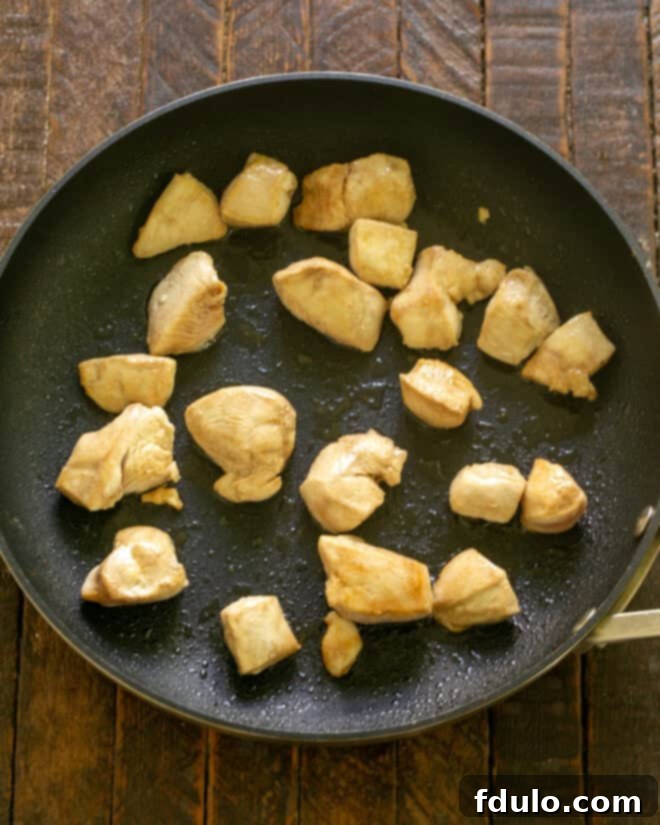
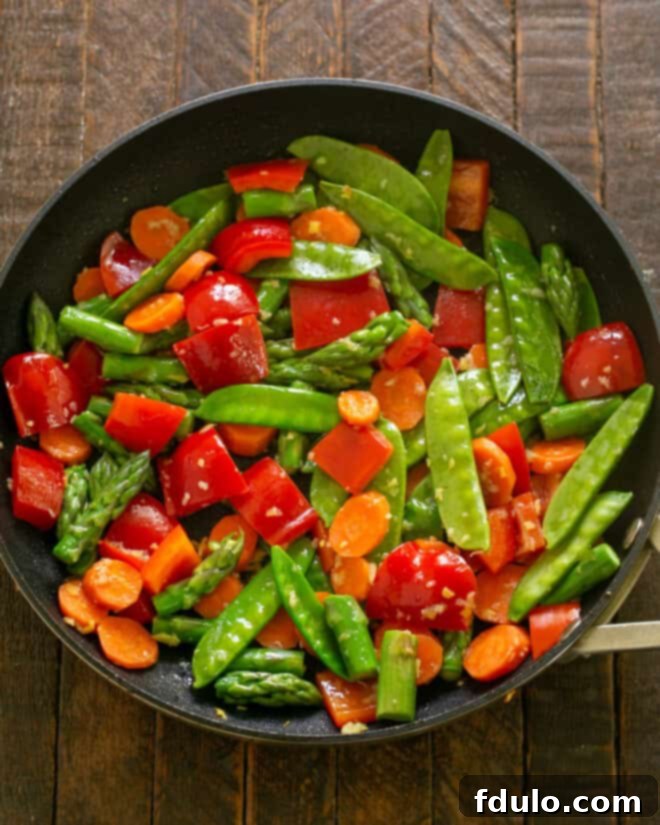

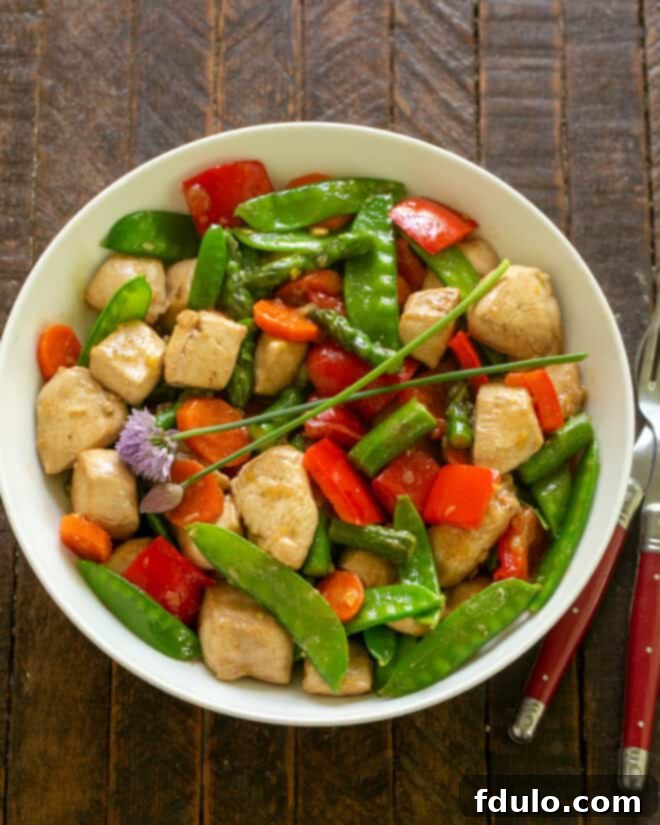
Expert Tips for Making Perfect Stir Fries Every Time
Achieving restaurant-quality stir fry at home is within reach with these key techniques:
- The Golden Rule: Prep Everything Ahead (Mise en Place): This is arguably the most crucial step for any stir fry. Before you even turn on the stove, have all your ingredients prepped and ready. Cut your vegetables, cube your chicken, mix your sauce, and even cook your rice. Keep everything organized in separate bowls in the refrigerator until you’re ready to cook. Stir-frying is a very fast process, and once you start, there’s no time to chop!
- PRO-Tip: Marinate Your Protein for Flavor and Tenderness: Marinating your chicken (or any protein) allows it to absorb flavor deeply and tenderize, especially if the marinade contains acidic ingredients like sherry. For chicken, a minimum of 30 minutes is good, but overnight (6-8 hours) in the refrigerator is even better for maximum flavor penetration and tenderness. Be mindful of USDA guidelines for marinating times: 6-24 hours for chicken and 3-5 days for pork, beef, and lamb. Over-marinating, especially with strong acids, can lead to mushy meat.
- Prepare Your Sauces in Advance: Just like your other ingredients, have your stir fry sauce pre-mixed and ready to pour. This prevents frantic scrambling mid-cook and ensures all flavors are evenly distributed.
- Speed is Key: Once your prep is done, the actual cooking time for a stir fry is incredibly fast – often 20 minutes or less. This makes it an ideal option for quick weeknight dinners.
- Customize Your Vegetables: Don’t be afraid to experiment! Stir fries are incredibly flexible. Swap out the suggested vegetables for varieties your family loves or whatever is fresh and in season. Excellent additions include broccoli, snap peas, bok choy, mushrooms, water chestnuts, or even thinly sliced cabbage.
- PRO-Tip: Cook Vegetables Strategically: To ensure all your vegetables are perfectly tender-crisp at the same time, add the harder vegetables (like carrots, broccoli florets, and bell peppers) to the wok first. Allow them to cook for a few minutes before adding softer, quicker-cooking vegetables (like snow peas or mushrooms).
- PRO-Tip: Achieve Thin Slices with Ease: If you’re aiming for very thin, uniform slices of chicken or beef, try partially freezing the meat for 20-30 minutes beforehand. It makes slicing much easier and safer.
- Experiment with Proteins: While chicken is fantastic, feel free to try beef (flank steak or sirloin work well) or shrimp. Remember that cooking times will vary: shrimp cooks very quickly (2-3 minutes), while beef might need slightly less time than chicken, depending on thickness. Always cook proteins in batches to prevent overcrowding the pan.
- Use the Right Oil: Always opt for a neutral cooking oil with a high smoke point, such as peanut oil, canola oil, or vegetable oil. Avoid olive oil, as its low smoke point can lead to burning and unpleasant flavors at the high temperatures required for stir-frying.
- Don’t Overcrowd the Pan: This is critical! Cooking in batches ensures your ingredients fry and sear beautifully, developing rich flavors and textures. Overcrowding cools down the pan, causing ingredients to steam instead of stir-fry, resulting in a soggy, less flavorful dish.
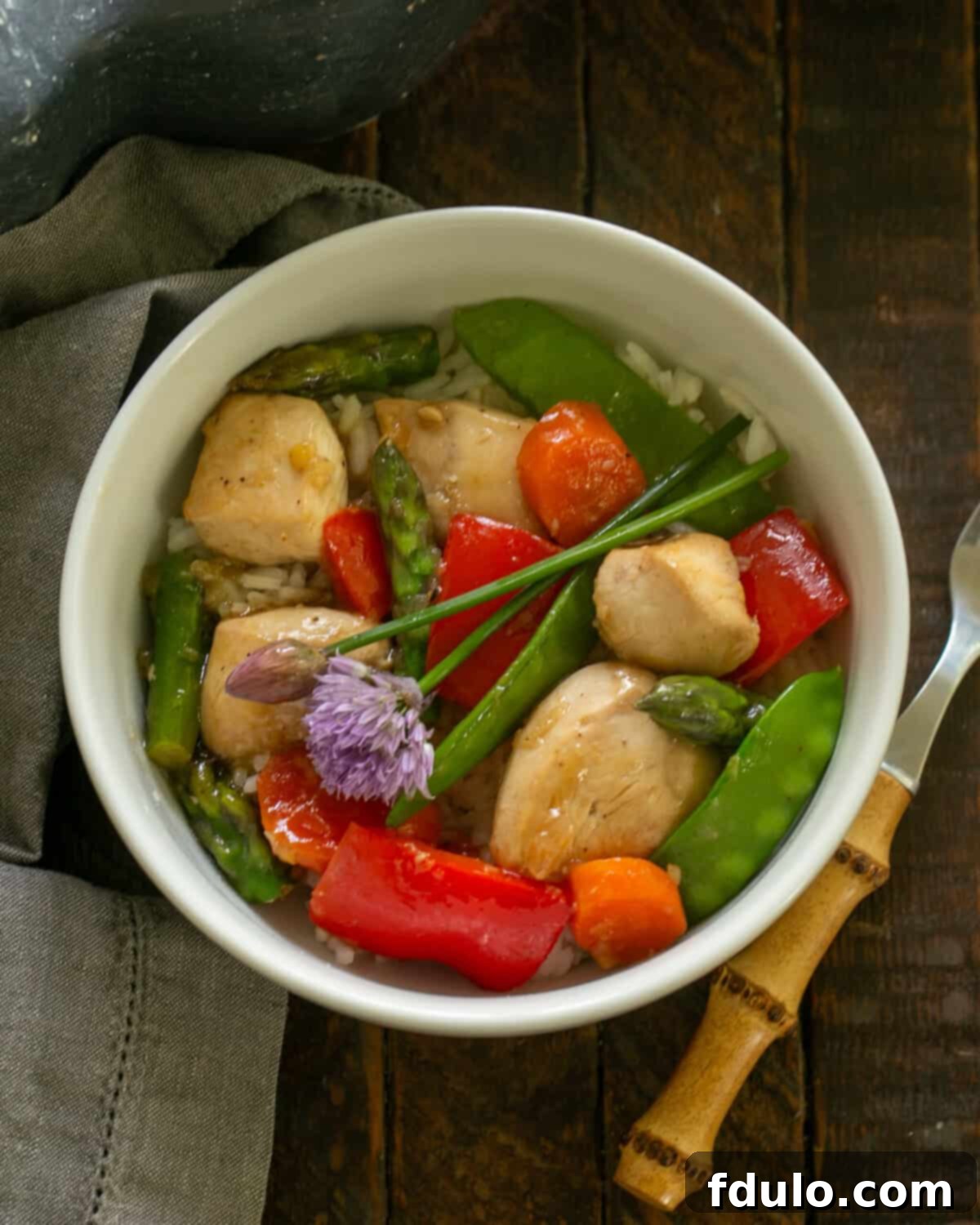
Making Your Stir Fry the Best It Can Be
To ensure your healthy chicken stir fry is always a success, keep these additional considerations in mind:
- Vegetable and Protein Harmony: For this healthy chicken stir fry, you have a wealth of options for both vegetables and protein. I often use a mix of cabbage, red bell pepper, carrots, broccoli, and pea pods, sometimes adding mushrooms. On this particular occasion, I had fresh asparagus to use up, and I humored my picky husband by omitting mushrooms. The key is to choose fresh, vibrant produce.
- Uniformity in Cutting: It cannot be stressed enough: have your vegetables cut into similarly sized pieces so they finish cooking at the same time. This applies equally to your chicken or other protein pieces. Consistency is key to a perfectly cooked stir fry.
- Avoid Overcooking Your Veggies: The hallmark of a great stir fry is tender-crisp vegetables. Mushy carrots or limp broccoli are far less appealing than those that offer a slight resistance when pierced with a knife or fork. Cook just until they retain a vibrant color and a pleasant crunch.
- Hot Pan, Cold Oil: A crucial technique for stir-frying is to get your wok or pan screaming hot before adding oil. Then, add your oil, let it heat for a moment, and *then* add your ingredients. This creates a non-stick surface and ensures a proper sear.
- Cook in Batches: As mentioned, this prevents your stir fry from steaming. Give each batch of protein or vegetables enough space to brown and develop flavor.
Packed full of nutrient-rich vegetables and lean protein, this healthy entrée provides a fulfilling meal that leaves room for a small, sweet bite after dinner – always a bonus! I sincerely hope you’ll add this Easy Chicken Stir Fry with Oyster Sauce to your regular meal rotation soon. It’s a game-changer for homemade Asian cuisine.
Frequently Asked Questions About Chicken Stir Fry
The absolute first key is thorough preparation (mise en place) – have all ingredients chopped and ready before you start cooking. Next, use a very hot pan (or wok) and a high smoke point oil. Cook your meat in batches first until nearly done, remove it, then stir-fry your vegetables until tender-crisp. Finally, return the meat to the pan with the sauce to finish cooking and coat everything evenly, ensuring the meat remains juicy and tender.
Absolutely! If your stir fry needs a flavor boost, consider enhancing the sauce. You can add a splash of chicken or vegetable broth for more liquid and depth, extra minced garlic or ginger for a bolder aromatic profile, a dash more soy sauce or oyster sauce for umami, a touch of rice vinegar for brightness, or even some chili flakes for a subtle kick. Fresh herbs like cilantro or scallions added at the end also brighten the dish.
Steamed white or brown rice is the classic and most essential accompaniment for a chicken stir fry, perfectly soaking up the delicious sauce. Other excellent alternatives include fried rice, quinoa, or even noodles like lo mein or chow mein. For a more elaborate meal, consider serving Wonton Soup, Hot and Sour Soup, crispy Egg Rolls, fresh Spring Rolls, or savory Chinese Dumplings as side dishes.
Traditionally, a carbon steel wok is ideal due to its ability to retain and distribute high heat evenly, creating the signature “wok hei” (breath of the wok) flavor. However, a large, heavy-bottomed skillet or a cast-iron pan can also work very well. The key is to use a pan that can get and stay very hot, and that is large enough to allow ingredients to spread out and sear without overcrowding.
To prevent a watery stir fry, focus on high heat and not overcrowding your pan. Cook proteins and vegetables in separate batches if necessary, allowing them to sear rather than steam. Ensure your pan is screaming hot before adding ingredients, and don’t stir too frequently, letting the ingredients get some color. The cornstarch in the sauce will also help thicken the liquids, but proper cooking technique is paramount.
More Asian-Inspired Recipes You May Also Love:
- 15-Minute Shrimp, Snow Pea, and Ginger Stir Fry from A Beautiful Plate
- Sticky Sweet Orange Chicken from The Noshery
- Classic Beef Broccoli Stir Fry
- Authentic Korean Beef Bulgogi
- Quick Asian Beef with Peppers for Weeknight Dinners
- Chicken, Bell Pepper, and Broccoli Stir Fry
- Flavorful Shredded Chicken Lettuce Wraps
- Plus, explore all my favorite Chicken Recipes for more culinary inspiration.
Stay connected for more delicious recipes and kitchen tips! Follow me on Instagram, Facebook, and Pinterest. Don’t forget to tag me when you whip up one of my creations! If you love the results, please consider leaving a 5-star rating in the recipe card below to help other home cooks discover these fantastic dishes.
Chicken Stir Fry with Oyster Sauce Recipe
This “better than takeout” recipe is adapted from The Perfect Recipe by Pam Anderson, designed for delicious homemade results.
Cook Time: 20 minutes
Total Time: 30 minutes
Yield: 4 servings
Ingredients
- 1 pound boneless, skinless chicken breasts, thinly sliced or cubed
- 1 tablespoon low-sodium soy sauce
- 1 tablespoon dry sherry
- 1 ½ pounds assorted vegetables, cut approximately the same size as chicken (e.g., snow peas, asparagus, red bell pepper, carrots, broccoli)
For the Stir Fry Sauce:
- 2 tablespoons oyster sauce
- 3 tablespoons dry sherry
- 1 tablespoon sesame oil
- ½ teaspoon granulated sugar
- ¼ teaspoon ground black pepper
- 3 tablespoons vegetable oil, divided
- 1 tablespoon minced fresh garlic
- 2 teaspoons minced fresh ginger
- 1 tablespoon cornstarch mixed with 2 tablespoons cold water (slurry)
- Steamed rice, for serving
Instructions
- In a medium bowl, toss the sliced chicken with 1 tablespoon soy sauce and 1 tablespoon dry sherry. Set aside to marinate while you prepare other ingredients.
- If using hard vegetables like carrots or broccoli, bring a large saucepan of salted water to a boil. Blanch these harder vegetables for 1-2 minutes until slightly softened but still crisp. Remove with a slotted spoon and set aside. (Alternatively, you can stir-fry them longer in the wok.)
- In a small bowl, whisk together the oyster sauce, 3 tablespoons dry sherry, sesame oil, sugar, and black pepper to create the stir-fry sauce. Set aside. In a separate small bowl, mix cornstarch with 2 tablespoons cold water until smooth to form a slurry.
- Heat 1 tablespoon of vegetable oil in a large sauté pan or wok over high heat until shimmering. Add half of the marinated chicken in a single layer and cook for 2-3 minutes until browned and cooked through. Remove the chicken to a clean serving dish. Add another tablespoon of oil to the pan and cook the remaining chicken batch. Remove and add to the serving dish with the first batch.
- Add the last tablespoon of vegetable oil to the hot pan. Add the minced garlic and ginger, stir-frying for about 30 seconds until fragrant (be careful not to burn).
- Add your softer vegetables (like snow peas, bell peppers, asparagus) to the pan and stir-fry for 2-4 minutes until tender-crisp. If you blanched hard vegetables earlier, add them now.
- Return all the cooked chicken to the pan with the stir-fried vegetables.
- Give the prepared stir-fry sauce a quick whisk, then pour it over the chicken and vegetables. Stir to coat all pieces evenly. Immediately add the cornstarch slurry to the pan, stirring continuously. Cook for 1-2 minutes until the sauce thickens to your desired consistency.
- Serve the hot chicken stir fry immediately over freshly steamed rice. Enjoy your homemade takeout-style meal!
Notes
Feel free to substitute chicken with beef (thinly sliced flank or sirloin) or shrimp. Adjust cooking times accordingly; shrimp cooks very quickly. You can also swap out any of the vegetables for your family’s favorites, such as bok choy, snap peas, mushrooms, or water chestnuts. If you’re not a fan of rice, quinoa or even brown rice noodles would be delicious alternatives to serve with this flavorful stir fry.
Recommended Products
As an Amazon Associate and member of other affiliate programs, I earn from qualifying purchases.
- OXO Measuring Beakers
- Heat-Resistant Silicone Spatula
- High-Quality Nonstick Skillet (like Scanpan)
Nutrition Information:
Yield: 4 servings | Serving Size: 1
Amount Per Serving (estimated):
Calories: 542 | Total Fat: 21g | Saturated Fat: 3g | Trans Fat: 0g | Unsaturated Fat: 16g | Cholesterol: 116mg | Sodium: 497mg | Carbohydrates: 39g | Fiber: 8g | Sugar: 6g | Protein: 47g
thatskinnychickcanbake.com occasionally offers nutritional information for recipes contained on this site. This information is provided as a courtesy and is an estimate only. This information comes from online calculators. Although thatskinnychickcanbake.com attempts to provide accurate nutritional information, these figures are only estimates. Varying factors such as product types or brands purchased can change the nutritional information in any given recipe. Also, many recipes on thatskinnychickcanbake.com recommend toppings, which may or may not be listed as optional and nutritional information for these added toppings is not listed. Other factors may change the nutritional information such as when the salt amount is listed “to taste,” it is not calculated into the recipe as the amount will vary. Also, different online calculators can provide different results. To obtain the most accurate representation of the nutritional information in any given recipe, you should calculate the nutritional information with the actual ingredients used in your recipe. You are solely responsible for ensuring that any nutritional information obtained is accurate.
